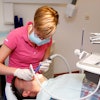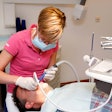
High levels of pretreatment anxiety were reported in about a third of patients awaiting their regular dental hygiene appointments in a new, if small, study published in BMC Oral Health.
Dental phobia and anxiety appear to have remained constant over the past 50 years, despite advances in technology and treatment delivery, the European researchers noted (BMC Oral Health, March 24, 2016, Vol. 16:43). Increased levels of anxiety may affect a patient's receptiveness to treatment, healthcare information, and behavior modification. Fear of the unknown, perceived unpredictability of dental treatment, and expectation of pain have been mentioned as factors for dental anxiety.
 Deborah Hofer, RDH, research associate, Center of Dental Medicine, University of Zurich, Switzerland.
Deborah Hofer, RDH, research associate, Center of Dental Medicine, University of Zurich, Switzerland."We did not expect that so many patients who attend maintenance therapy visits on such a regular basis experience recurring pretreatment anxiety for what we consider to be a routine (harmless) preventive procedure," study author Deborah Hofer, RDH, told DrBicuspid.com.
Hofer is a research associate at the Clinic of Preventive Dentistry, Periodontology, and Cariology in the Center of Dental Medicine at the University of Zurich in Switzerland.
"Despite not being able to pinpoint why so many patients suffer a relevant degree of anxiety prior to dental hygiene recall treatment, it remains incumbent upon the treating hygienist to help these patients overcome negative feelings associated with preventive/maintenance therapy," she said.
Measuring patient anxiety
In contrast to general dental procedures, routine dental hygiene recall/maintenance appointments involve a range of procedures (recording clinical parameters, oral hygiene evaluation/reinstruction, scaling of soft and hard deposits, fluoride application) that are predictable, according to the study authors. Average dental hygiene appointments are one hour., they noted.
The anxiety levels of 46 adult patients at the University of Zurich's dental clinic were measured in this 2009 pilot study. All patients were awaiting their regularly scheduled hygiene appointment. The hygiene treatment included recording plaque/bleeding indexes, oral hygiene instruction, and the removal of plaque and light calculus.
The researchers asked the patients to fill out a short series of questions. They then analyzed the patient responses to measure the following:
- Dental anxiety
- Expected pain
- Feelings of stress or relaxation
- General mood and alertness pretreatment
- General anxiety felt simply by being in a dental clinic
“It remains incumbent upon the treating hygienist to help these patients overcome negative feelings associated with preventive/maintenance therapy.”
The patients were divided into groups that displayed high anxiety (n = 14) and low anxiety (n = 32). The two groups reported having different moods before the treatment. Low-anxiety patients were in a significantly better mood (p < 0.001), were more awake, (p < 0.001), and calmer (p < 0.001) compared with the high-anxiety group.
The two groups were similar in gender division, their total number of dental hygiene appointments, and the average number of dental hygiene visits per year. However, the low-anxiety group was older than the high-anxiety group (55 years versus 42 years, p = 0.018), revealing an apparent trend for anxiety to recede with age.
Notably, the two groups had similar earlier treatments (such as extractions, periodontal surgeries, implants, root canal treatments, and/or restorations). However, the high-anxiety group had more gingivitis, and the low-anxiety group had more periodontitis (p = 0.005). The high-anxiety group also reported higher pretreatment stress levels and tended to anticipate more pain during treatment than the low-anxiety group.
The findings are similar to earlier studies and are attributed to painful procedures (probing, scaling, administration of anesthesia), contextual stimuli (sound of the ultrasonic and polishing handpieces, vibration sensation on the teeth, dental office smell), and past dental/dental hygiene experiences (Journal of Dental Education, November 1, 2004, Vol. 68:11, pp. 1172-1177; Journal of the American Dental Association, August 2003, Vol. 134:8, pp. 1101-1108).
However, in this study the researchers found that procedures that could be classified as painful (or at least invasive) such as implant placement, periodontal surgery, multiple restorations, extractions, and root canal treatment were not correlated with increased anxiety. Interestingly, aside from age, gingivitis was the only other factor correlated to increased anxiety levels.
"People are often afraid of the unknown," researcher Hofer explained. "When imagining a procedure such as implant placement, periodontal surgery, extraction of a tooth, root canal therapy, and even the placement of a restoration, depending upon a person's prior experience, various degrees of trepidation prior to the procedure are to be expected. However, after the fact, the actual experience is no longer unknown, and thanks to adequate pain management, neither anxiety producing to think about nor remembered to be especially painful."
Anxiety levels for the patients who were questioned in the waiting room prior to dental hygiene treatment were relatively high, the researchers found.
"While pretreatment anxiety is a well-documented phenomenon, recognition that it also affected one-third of our dental hygiene recall population again sheds light on the importance of its management," Hofer said. "There remains a great need to determine which patients fall into a high-anxiety group and offer anxiety-reducing strategies prior to treatment and/or increased pain management techniques integrated into the procedures performed."



















